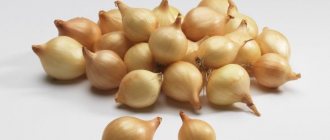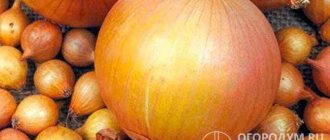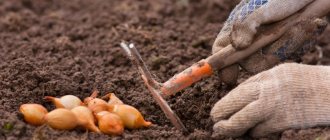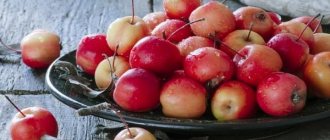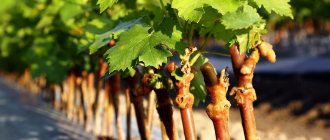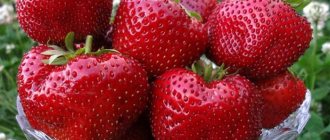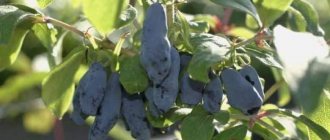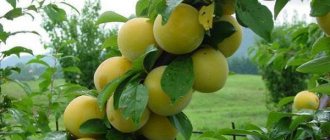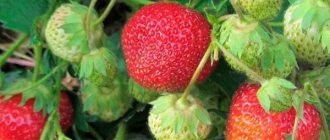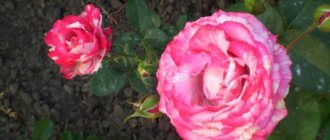Many gardeners and farmers are engaged in growing onions, so there are many varieties and hybrids of this vegetable. From all the variety of crop varieties, vegetable growers try to choose those that best suit their tastes. For example, a fairly significant part of vegetable growers choose the Golden Semko F1 onion. This is a domestically produced hybrid with many remarkable qualities and very minor disadvantages. Let's consider its characteristics and cultivation techniques.
Characteristics
“Golden Semko” belongs to the early ripening varieties; the harvest can be harvested 75-80 days after emergence.
During this time, an excellent round-shaped bulb weighing from 70 to 100 grams manages to form from a tiny seed. The neck is thin, dry scales are golden in color, the bulbs are small-nested, the variety is not suitable for growing green feathers. The onion tastes semi-sharp, which allows it to be used in various dishes and added to fresh salads. It also causes far fewer tears when cleaning. Interesting! Onions have a positive effect on the immune system, improve appetite and promote better absorption of food.
The hybrid is almost not susceptible to common diseases and is characterized by high productivity; 2.5-3 months after sowing, up to 5 kg of onions can be obtained from 1 m2. Also, the variety can be stored for a long time, for 5-7 months, on average, only 5% of the harvest spoils. It can be cultivated throughout the country, but in the south it is grown as an annual crop, and in the northern regions onions ripen from sets in the second year.
Interesting fact! Onions contain more sugar than apples or pears.
Advantages
- Growing onions in 1 sowing season.
- Possibility of long-term storage.
- Variety resistance to diseases.
- It can be grown both from seeds and from sets.
- Attractive appearance.
- Excellent adaptability to any soil and climate.
Flaws
- The variety is not suitable for growing greens.
Productivity
This hybrid is recommended for growing as an annual crop in open ground everywhere: both in the southern regions and in areas with a less comfortable climate. A high yield of marketable products is obtained using the traditional method of planting sets, pre-winter or spring sowing of seeds. According to experienced vegetable growers, the largest turnips are formed when cultivated using the seedling method.
Onions “Golden Semko” are grown from seeds (including through seedlings) in an annual crop in both the southern and northern regions of Russia, Ukraine, Belarus and other neighboring countries
The yield and marketability of turnips depend on weather and climatic conditions, the mechanical and chemical composition of the soil, and the intensity of agricultural technology used. The quality and keeping quality of the bulbs can be negatively affected by insufficient lighting (prolonged cloudiness) and heavy rains. Overmoistening of the soil leads to a decrease or death of onion yield during the growing season and storage.
Growing methods
Seeds of this variety have a relatively high price. This is due to the fact that “Golden Semko” is very profitable to cultivate using seedlings. Experienced agronomists sow seeds before winter in order to get seedlings when spring arrives. With this method of sowing, the harvest is earlier and more abundant. But in this case, you need to use 10% more seed, since not all grains will survive the winter. Before planting, the seeds are checked for germination; to do this, take 10 pieces and wrap them in a damp cloth, and germinate for three days; if 7 out of 10 have sprouted, it means they are suitable for sowing. We must not forget about pre-treatment with disinfectants.
You can also grow onions from sets; this method is used in cold regions, or for an earlier harvest. In order to get a decent result, it is very important to select high-quality bulbs with a diameter of 1 to 3 cm. They should be:
- Dense;
- without any damage;
- dry;
- no foreign odor;
Before planting, it is dried for a week at a temperature of 35-40 degrees and treated with a solution of copper sulfate
Description
The hybrid forms round bulbs with a thin neck, which retain a sharp and slightly spicy taste and beneficial properties for more than 7 months.
Origin and development
Golden Semko is the result of the work of domestic Moscow breeders. It was included in the State Register of the Russian Federation in 2000.
Composition and beneficial properties
Golden Semko onion contains:
- essential oils;
- vitamins C, PP, group B;
- phytoncides;
- potassium;
- zinc;
- iron.
The vegetable improves metabolism, has restorative and antibacterial effects, promotes the elimination of toxins, and reduces the risk of developing cancer.
Ripening time and yield
This is an early ripening hybrid: vegetables are harvested 80–90 days after germination.
Commercial yield is on average 3.3–3.5 kg/m2.
Immunity
Although Golden Semko is resistant to common diseases and pests, due to non-compliance with agricultural practices it is affected by:
- root rot;
- fusarium;
- onion flies;
- thrips;
- caterpillars.
Characteristics
The hybrid has long, about 35 cm, hollow leaves of a rich green color and single round bulbs. Turnips weigh 75–80 g, covered with 2-3 golden dry scales.
The pulp is white, dense. The aroma is characteristic of onions, the taste is pungent.
Important! The hybrid adapts well to various climatic conditions, so it is grown in all regions of the country.
Growing from seeds
The soil is pre-moistened, then shallow grooves are made in it at a distance of 5-10 centimeters. When laying out the seeds, leave 1.5 centimeters between them. Then the seeds are sprinkled with soil and watered. At the end, the planting needs to be covered with film, this will create a greenhouse effect and speed up the emergence of seedlings. When sprouts appear on the soil surface, the cover is removed.
In the future, the seedlings must be regularly watered and loosened. For irrigation, it is better to use settled water at room temperature. Before planting in the soil, young plants need to be hardened off.
Difficulties in growing
The main problems when cultivating a hybrid:
- low yields or small turnips are the result of violation of crop rotation rules, planting in acidified or too heavy soil;
- premature drying and yellowing of leaves indicates a lack of moisture;
- the bulbs do not fully ripen by the time of harvest due to excessive watering and constant fertilizing;
- pale and thin leaves indicate a lack of nitrogen-containing fertilizers, and wilting and blackening of the tops of the foliage indicate a deficiency of fluoride.
Transferring seedlings to a permanent place
Typically, seedlings are transplanted in April, by which time they should be at least 50 days old. Before planting, the soil is plowed, leveled and watered abundantly. Then shallow holes are made in the ground, the distance between them should be approximately 10 cm. Then the onion seedlings are transplanted to a new place and watered. Subsequently, you need to water the onions once every 14 days. Loosen the soil at least once a month.
Main advantages and disadvantages
Advantages of Golden Semko onion:
- high yield, independent of weather conditions;
- friendly ripening of bulbs;
- ripening up to 99% before harvesting;
- high shelf life: 95% of the crop is stored for 7 months;
- ease of care;
- resistance to drought, temperature fluctuations, diseases and pests.
Flaws:
- later ripening of the crop in the northern regions;
- short growing season of the above-ground part.
Differences from others
Comparative table of some onion hybrids:
| Hybrid | Ripening period | Productivity, kg/m2 | Bulb shape | Bulb weight, g | Taste |
| Golden Semko | Early ripening | 3,3–3,5 | Round | 75–80 | Spicy |
| Zodiac | Late ripening | 5,9 | Round | 110–300 | Sweet |
| Viking | Early ripening | 5,1 | Round | 110–250 | Sweet |
Planting sets
The sets are planted in pre-fertilized soil, the holes are made 5 cm deep, 20 cm are left between rows, and 10-15 cm between bulbs. When the planting procedure is completed, I fill the furrows with substrate and compact them a little. It is advisable to do this in cloudy weather. Sevok can be planted both in spring and autumn.
You may be interested in: Harvesting onions according to the lunar calendar 2021 in Siberia Dates for harvesting onions in 2021 in the Urals Favorable days for harvesting onions in 2021
Harvest and storage
The main signs of ripeness of vegetables are lodging of leaves and drying of the neck of the bulbs.
Turnips are collected in the second half of July, on a clear, dry day, carefully pulling them out of the ground by their feathers.
Storage features and shelf life
The harvested crop is carefully inspected and sorted, rotten and spoiled vegetables are removed. A specimen with mechanical damage is set aside for immediate use.
The onions are laid out in the sun or under a canopy for about 2 weeks so that they dry well. Then they are placed in nets or wooden boxes and taken out to a dark, well-ventilated room with a temperature of +2...+10°C.
In the right conditions, Golden Semko is stored for a long time: after 7 months, only 5% of the crop spoils.
Growing and care
To obtain maximum yield, it is necessary to create favorable conditions for the crop. Onions love light, warmth and do not tolerate drafts. Therefore, you need to choose a site that is sunny and protected from the wind. An important rule when growing any crops is to observe crop rotation; onions grow well after cucumbers and potatoes. You cannot plant where garlic and onions were located last year.
The variety is unpretentious in terms of soil composition, the main thing is neutral acidity and fertilization with organic matter before planting; in the future, the crop does not need fertilizing. “Golden Semko” tolerates low temperatures well, but the main thing is that it does not drag on for too long, otherwise the bulbs may die. The process of seed germination and sowing begins at a temperature of +4. To form the onion, the temperature must be at least +12 degrees.
Important! When planted in the shade, the bow shrinks and shoots arrows.
It needs to be watered as the soil dries, after which it is advisable to loosen the rows. You should also regularly weed the area to remove weeds. Three weeks before harvest, watering should be stopped.
Optimal growing conditions
Golden Semko is an unpretentious crop, but to obtain a good harvest, several conditions must be met:
- The site is on a hill. Cold lowlands have a bad effect on the development of crops, as a result of which the harvest will suffer.
- Sufficient illumination of the area.
- Wind protection. Culture does not like drafts.
- Following the rules of crop rotation. It is better to plant onions after pumpkins, nightshades, white cabbage or kohlrabi, celery, spinach and lettuce. Bad neighbors are garlic, legumes, dill, parsley, and broccoli. Onions should not be replanted in the same area for 3 years.
- Avoiding prolonged exposure to low temperatures. If sowing is not winter, it is recommended to carry it out at a temperature of 4 degrees. Onions begin to form at a temperature of 12 degrees. The crop tolerates short frosts well.
- The right neighborhood. Onions feel good next to beets, carrots, tomatoes, any type of cabbage, lettuce, and chicory.
- Selection of planting material. This stage is very important, since when discarding seeds or sowing for planting, the harvest will be much greater than if such actions are ignored.
Place and soil for growing onions for greens
The feather vegetable grows in a well-lit place. The soil is selected depending on the requirements for growing the variety. The main requirement for obtaining lush greens is that the soil is regularly moistened.
In the greenhouse
The crop is grown in a greenhouse in winter or autumn with the onset of frost. The greenhouse is made of polycarbonate and equipped with a heating, lighting and irrigation system. Phytolamps are placed vertically: the greenery will be evenly developed on all sides.
The soil is selected with neutral acidity. Add 30 g of superphosphate and 15 g of potassium per 1 m2. In greenhouses, sets are planted or seeds are sown densely.
In March - April they grow in greenhouses made of film or dense agrofibre. They are planted in a greenhouse in the spring after artificial heating of the soil.
Pay attention to the video of growing onions:
In the open ground
In the vegetable garden, the vegetable is planted in any month when the soil warms up to at least +8 ºC to a depth of more than 4 cm. It is recommended to do the last planting in early August.
In autumn, in the onion plot, the soil is dug up 25 cm deep, plant debris is removed, and humus is added (5 kg/1 m2). In spring, loosen the soil 3 days before planting.
See what the harvest looks like on the site:
On the windowsill
A pot, plastic bottle or other suitable container is suitable for planting sets/small turnips. It is better to grow onions from seeds in a mini-greenhouse. Use universal soil or replace it with sawdust.
On hydroponics
To force greenery, a factory or homemade hydroponics device is used.
The kit includes:
- opaque container with cells and a lid;
- compressor;
- phytolamps;
- water heater.
No soil is needed. A nutrient solution (water with fertilizer) is poured into the container, the onions are inserted into the cells, and the device is started.
The device can be replaced with a glass or other container. A third of the volume of drinking or mineral water is poured into it. Insert a small onion so that the roots are immersed in the liquid. The water is changed daily and fed with ash.
In sawdust and bag
Feather forcing is done on sawdust. They are moistened and laid out in a thick layer in a baking tray, box or other container. Onions and filler are treated with potassium permanganate.
Onion greens are also grown in tight bags. A filler is placed inside to retain moisture. Suitable:
- universal soil;
- wet sawdust;
- moss;
- husks of cereals or sunflowers.
To prevent fungus, it is better not to tie bags.
Please watch a video about the method with the package:
In egg cells
The method is suitable for the kitchen. Paper egg trays are used instead of seedling cassettes (plastic ones are used for hydroponics). The cells are saturated with water or soil is poured inside. The onions are stuck in and the tray is placed on a pallet.
In a plastic container
Use a transparent bottle with a volume of 3–6 liters. Holes with a diameter of 5 cm are cut around the circumference. The holes are made in a checkerboard pattern.
A universal substrate is poured into the container. As the eggplant is filled, the onion is inserted into the holes with the spine inside the bottle. The turnip is slightly recessed, leaving the cut tail outside.
See 3 interesting ways to plant onions at home:
Features of the variety
Golden onion Semko belongs to the early ripening type. Full maturation occurs in 2.5 months. A distinctive feature of the variety is that it almost does not form nests and grows in single large bulbs. This means that Semko onions are not grown to produce green feathers.
Onion Semko Golden
The fruits have a round shape. The color of the husk is golden, uniform. When cutting onions, it practically does not cause tears. The taste is piquant, but not too spicy, so the fruits can be used fresh for salads or subjected to heat treatment.
Description of the main characteristics of the onion variety Golden Semko
| Index | Meaning |
| Productivity | 3.5 – 5 kg/m2 |
| Weight of 1 onion | 100 g. |
| Keeping quality | 0.95 |
| Storage duration | Up to 7 months |
| Sugar content | 0.065 |
| Dry matter content | 0.13 |
| Maturation at the time of harvesting | 95 % – 99 % |
High-quality Semko onions have a relatively high price, which is fully paid for by the resulting harvest. Regardless of the quality of the planting material, the final result directly depends on the care.
Boarding time
This criterion depends on the climatic characteristics of the region and the method of growing the crop. Since onions love light, their ripening should be adjusted to coincide with the longest period of the solstice.
Onion sets
It is considered optimal to plant in soil heated to +8°C with a stable air temperature above +10°C. Early planting in moist soil accelerates the development of the root system. Thanks to this, the crop is less attacked by the onion fly.
When planting, gardeners are guided by the principle “the sooner the better.” When the soil thaws by 5 cm, you can plant the seedlings. In the central zone of the Russian Federation, this period falls on the 20th of April, in the south - at the beginning of March, in the north - at the beginning of May.
If planted too early, onions may rot.
In addition to climatic conditions, planting time depends on the size of the seed:
- Small, up to 1 cm in diameter, planted in early spring or before winter.
- Large and medium-sized sets, up to 2.5 cm in diameter, are planted together with early potatoes.
There are a number of benefits to fall planting. Onions shoot less, and the harvest ripens earlier and is stored longer.
Autumn sowing allows the gardener to save a lot of time
Seeds
Depending on the region, the capabilities of the garden and the goals, the time for planting seeds in open ground differs.
Table 2. Timing for planting seeds in open ground
| Sowing No. | Deadlines | Peculiarities |
| I | Late autumn or early spring | Planting before winter is suitable for all regions of the Russian Federation, with the exception of the Far North. The soil under the snow layer does not freeze much, up to a maximum of -5°C, which is not harmful to the seeds. Sow at a temperature of +5°C in dry soil. In such conditions, they will not germinate and will not be damaged during frosts, but they will be perfectly preserved until spring. Planting in early spring is carried out when the soil has warmed up to +3°C. Melt water formed after snow melts will accelerate plant growth. Such crops have good yields, but the bulbs develop thick necks. This has a negative effect on onion storage. The maximum duration is no more than 3 months. |
| II | At ground temperatures from 10 to 12°C | In the temperate zone, this period falls on the 20th of April. Mostly small or medium-sized fruits ripen. The former are used for planting next year, and the latter for cooking. |
| III | At soil temperatures above 15°C | In central Russia, this period coincides with the beginning of May. The resulting harvest is completely used as planting material. |
Thanks to autumn sowing, the seeds are hardened and produce strong shoots
Seedling
Seedlings are planted in open ground after reaching 50 days. Depending on the region, this period stretches from mid-April to early May. The soil temperature must be at least 15°C. It is desirable that at the time of planting the seedlings have at least 3 leaves. Sowing seeds for seedlings begins after February 15.
Pre-grown onions using seedlings
Reviews
Reviews about the hybrid Golden Semko are mostly positive.
Vladimir, Tula: “I studied the descriptions of many varieties and hybrids - the Golden Semko onion caught my attention and tried to plant it. I liked his ability to adapt to weather conditions. There is no need to be afraid of slight temperature fluctuations: this will not affect the harvest. Other advantages of the hybrid are high productivity and long-term storage.”
Maria, Kazan: “Our family loves onions: we eat them fresh and add them to various dishes. At the same time, I haven’t grown it myself before, but a year ago my godfather shared seedlings, and I decided to try it. The debut turned out to be successful: the harvest was rich, the turnips were beautiful and strong, the crop needed minimal care.”
Landing dates
Onions are a cold-resistant crop and can germinate at temperatures of +5C°, but the optimal temperature for planting will be +12C° +16C°. Short-term frosts are not dangerous for planting onion sets , but lower temperatures will harm the bulbs.
Winter sowing of seeds is successfully practiced. It is better to plant during a steady cold spell, when the thermometer shows no more than 3-4C°. Seeds that have undergone natural stratification produce early shoots and exhibit greater resistance to diseases characteristic of the variety.
Description of the variety
general characteristics
Rosanna onions are also known as Rosanna. The variety is mid-season, the growing season from germination to ripening is 90-100 days.
The green feather and bulbs are juicy. The taste is semi-sharp. The bulbs are rich in phytoncides and ascorbic acid.
Appearance
The plant reaches 30-35 cm in height. The bulbs are flat-rounded, dense, weight - 100-120 g, diameter about 8 cm. The outside is covered with pink scales, when dry they become covered with yellow spots. Inner scales are white.
Advantages and disadvantages
Pros:
- not demanding and not whimsical regarding the composition of the soil;
- stable yield;
- high ripening;
- well stored;
- not prone to the appearance of arrows for reproduction.
Cons: heat-loving.
Resistance to diseases and pests
The Rosanna variety is not affected by diseases and is resistant to onion pests:
- onion leaf eater;
- onion rust;
- viral mosaic.
Soil requirements
Rosanna onions cannot be planted in the same place every year. It is recommended to plant onions in beds where zucchini, cabbage, cucumbers, and tomatoes were previously grown; allowed to be planted after potatoes. For Rosanna onions, choose well-lit and level areas with fertile soil.
Taste
The Rosanna variety has juicy bulbs and a mild, sweet-spicy taste. The taste is less harsh compared to yellow varieties of onions, and more intense when compared to red varieties. Pleasant and sweet when eaten raw.
Keeping quality
Rosanna onions are stored throughout the winter and retain their quality for about 8 months. Keeping quality indicators, subject to storage conditions, remain at the level of 65-75%.
Usage
Onions of the Rosanna variety contain proteins, carbohydrates, fiber, and organic acids. The plant contains:
- vitamins B, C, PP, E;
- micro- and macroelements – potassium, sodium, magnesium, iron, phosphorus, manganese.
Due to its rich vitamin composition, it is recommended to add it to food to combat vitamin deficiency in early spring. Rosanna onions have a sweetish-sharp taste and are added fresh to salads. It retains its beneficial properties during heat treatment. Therefore, it is boiled, fried, dried and added as a seasoning to soups and stews. It goes well with meat dishes - it is often called kebab onions. The Rosanna variety is also salted and pickled.
Areas for cultivation
The Rosanna variety is suitable for cultivation in all regions of Russia. In more northern regions, it is necessary to monitor the level of soil moisture.
Growing technique
Golden Semko can be grown in 2 ways:
Tomato Semko
Seminal. Onion grains collected in the previous year are allowed for planting. Germination is assessed by germination on a damp cloth. To do this, 10 seeds are randomly selected and laid out on a cloth. The germination test is considered positive if 7 out of 10 seeds have germinated. High-quality seeds always have a rich black color;
It is important to know! Purchased material is often treated with drugs and nutrient mixtures, which is why the seeds are covered with multi-colored shells. This coating improves the quality of the seed material.
Planting with bulbs.
Planting onions
High-quality onion sets Golden Semko is distinguished by the following parameters:
- Bulb diameter – 1-3 cm;
- The surface is dense, without stains, scratches, rot or other deformations;
- The husk is well dried, so it rustles in your hands;
- The color of the husk is uniform;
- Healthy appearance and smell of husks. Visually there should be no rot, insects or traces of rodents. The bulb should not smell like spoiled material (dampness, rot).
Onions do not tolerate touching, so during winter storage they should not be handled frequently. This causes the bulbs to sprout and become unusable.
Landing conditions
Onion sets Red and Golden Semko germinate well in warm and well-lit areas with moderate soil moisture. The crop is not afraid of short-term frosts, but a drop in temperature below -6 ˚C destroys the bulbs. The ideal temperature is +12 ˚C...+16 ˚C, but even at +5 ˚C onions germinate freely.
It is better to choose fertile soil with a neutral or slightly alkaline environment for planting. The bed should be located in the zone of maximum illumination, since in the shade the bow becomes smaller, deforms and shoots arrows. It is better to avoid lowlands, as the soils there are heavy and damp. The optimal groundwater level is 1 meter.
Onion Semko in open ground
The best predecessors for onions are cucumbers, potatoes, tomatoes, and cabbage. It is strictly forbidden to sow Semko after any varieties of onions and garlic.
Onions love well-fertilized soil with organic matter. But applying fresh manure before planting onions is prohibited. It causes the development of rot and infections, and also contributes to the filling of the bed with weeds. It is best if the bed was fertilized with organic matter last year under its predecessor.
It is important to know! It is necessary to add a mineral complex of fertilizers. In autumn, ash, potassium, phosphorus and nitrogen, as well as humus, are added to the soil. To lighten the soil, it is allowed to add several buckets of sand to 1 bed.
Planting sets
Before planting, the seedlings are soaked in water or a solution of copper sulfate for 20 minutes. The bulbs are planted in furrows 5 cm deep, row spacing is 20 cm. The sets are placed 10 cm apart so that the top is visible by about 5 mm. If you deepen the bulbs too much, the crop will have an irregular elongated shape. If you place them close to the surface, the bulbs will grow ugly. After all the planting material has been placed in the furrows, a layer of soft and loose earth is poured on top. At the end of the work, the top layer is leveled with a rake.
Sowing seeds
Growing onions from seeds
Sowing is carried out in furrows, 2 cm deep. The distance between the rows is 5-10 cm. The seeds are laid out individually, retreating 1.5-2 cm. There is no need to sow Semko densely, as this makes it develop poorly. After placing all the grains in the furrows, they are sprinkled with earth, the top layer is slightly pressed down and watered. To speed up germination and protect against weeds, the bed can be covered with film or material. As soon as the first shoots appear, the shelter is removed. Normally, sprouts germinate in 1.5-2 weeks. Growing onions from seeds is important for the southern regions, where the climate allows you to get a harvest of their seeds in one year. In other cases, it is better to use planting sets.
Onion care
Watering
Golden Semko loves moist soil, especially in the first 2 months from planting. Water helps the onion to fill. For irrigation you will need warm, settled water. On average, an onion bed needs to be watered once a week. The frequency of watering may vary depending on weather conditions. During rains, watering should be stopped, as excess moisture leads to rotting of the bulbs. In dry summers, the amount of watering must be increased, otherwise the onions will be lifeless and dried out.
Watering onions
Weeding and loosening
Onions are extremely demanding on soil conditions. During the active growth phase, you need to weed and loosen the soil as often as possible. When weeds overrun the garden bed, the onion greatly loses its yield. The same applies to soft soil. In loose soil, the bulbs develop much more actively, and air exchange also improves.
Fertilizer application
For onions, it is necessary to apply 3 fertilizers. The first is done in the fall, at the time of preliminary preparation of the land for the coming summer season. Autumn feeding is usually the most generous. The second fertilizing is applied in the spring immediately before planting the onions. A solution of bird droppings or manure works well. The consumption rate is 3 liters of diluted infusion per 1 m2. 2 weeks after sowing, the third feeding is carried out. It is needed to provide strength and energy for the active growth of the bulbs. Urea (30 g) dissolved in 10 liters of water is suitable as a fertilizer.
Onion feeding
Diseases and pests
The main pests of Semko onions are:
- Onion fly,
- caterpillars,
- Thrips,
- Medvedki.
Planting carrots and onions together is suitable as a preventive measure. These plants are protectors for each other. Their aroma repels insects. Also an effective preventive measure is pre-sowing seed treatment and sowing with a 1% solution of copper sulfate. Already sprouted bulbs can be sprayed with a soap solution.
Important! If preventive measures have not brought results, and insects have attacked the onion beds, it is necessary to carry out insecticidal treatments with chemicals. The most effective drugs are Actellik and Aktara.
If growing conditions are not observed and in particularly unfavorable climatic zones, Semko onions may be susceptible to fungal diseases:
- powdery mildew,
- All types of rot,
- Fusarium,
- Various spots.
Downy mildew on onion
Active development of the fungus occurs in acidic soils. Therefore, it is imperative to do liming with dolomite flour (400 g/m2). As a preventative measure, it is necessary to carefully select planting material. Any suspicious bulbs should be removed. It is also worth paying close attention to soil moisture, since most fungi begin to multiply in waterlogged soil. As a control measure, you need to spray the beds with fungicides: Skor, Maxim, Previkur.
Cleaning
Harvesting begins when the above-ground part falls to the ground and dries out. Around the second ten days of July, the period of full ripening of Semko begins. Cleaning should be done in dry, sunny weather. The bulbs are pulled out of the ground and laid out on the garden bed so that they can dry. Then the crop is transferred to a dry, dark place to dry. The bulbs should lie there for 15 days. Before storing, you need to cut off the tops, leaving a tail of 5-7 cm.
